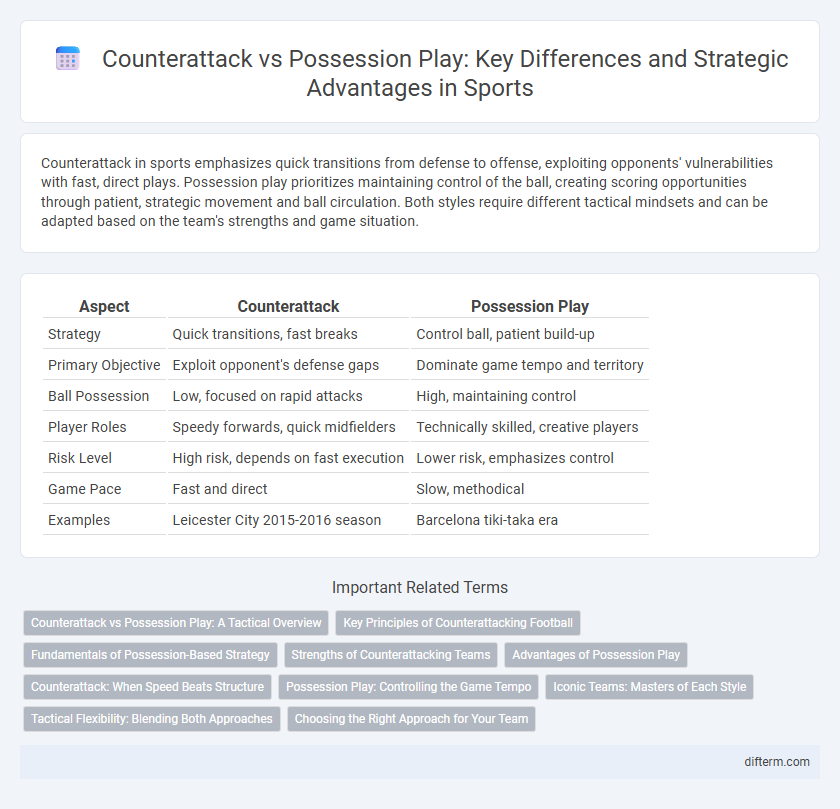Counterattack in sports emphasizes quick transitions from defense to offense, exploiting opponents' vulnerabilities with fast, direct plays. Possession play prioritizes maintaining control of the ball, creating scoring opportunities through patient, strategic movement and ball circulation. Both styles require different tactical mindsets and can be adapted based on the team's strengths and game situation.
Table of Comparison
| Aspect | Counterattack | Possession Play |
|---|---|---|
| Strategy | Quick transitions, fast breaks | Control ball, patient build-up |
| Primary Objective | Exploit opponent's defense gaps | Dominate game tempo and territory |
| Ball Possession | Low, focused on rapid attacks | High, maintaining control |
| Player Roles | Speedy forwards, quick midfielders | Technically skilled, creative players |
| Risk Level | High risk, depends on fast execution | Lower risk, emphasizes control |
| Game Pace | Fast and direct | Slow, methodical |
| Examples | Leicester City 2015-2016 season | Barcelona tiki-taka era |
Counterattack vs Possession Play: A Tactical Overview
Counterattack relies on rapid transitions from defense to offense, exploiting opponents' space during their attacking phase, which demands speed and precision in passing. Possession play emphasizes maintaining control of the ball through short passes and spatial awareness to dominate the game's tempo and reduce opponents' opportunities. Tactical success depends on team strengths, with counterattack favoring quick, agile players and possession play benefiting technically skilled, patient teams.
Key Principles of Counterattacking Football
Counterattacking football emphasizes rapid transitions from defense to offense, exploiting space behind opposing defenders with quick, precise passes. Key principles include maintaining a compact defensive shape, instantly launching forward runs by attackers, and prioritizing speed over prolonged possession. Effective counterattacks rely on high pressing to regain possession and swift decision-making to capitalize on opponent vulnerabilities.
Fundamentals of Possession-Based Strategy
Possession-based strategy in sports emphasizes controlling the ball through precise passing, spatial awareness, and maintaining team shape to dictate the game tempo. Key fundamentals include patient buildup, exploiting open spaces, and consistent ball retention to wear down opponents. Mastery of technical skills, such as quick decision-making and effective communication, is essential for sustaining possession and creating scoring opportunities.
Strengths of Counterattacking Teams
Counterattacking teams excel at exploiting spaces quickly, using rapid transitions to catch opponents off guard and create high-quality goal-scoring opportunities. Their strength lies in defender speed and precise forward passes that maximize efficiency during turnovers. This approach minimizes possession risk, allowing counterattacking teams to capitalize on opponent vulnerabilities with swift, direct attacks.
Advantages of Possession Play
Possession play enhances team control by allowing players to dictate the tempo and create higher-quality scoring opportunities through sustained ball retention. This strategy minimizes the opponent's chances to attack by restricting their possession time, leading to improved defensive stability. Maintaining possession also fosters better spatial awareness and cohesive teamwork, contributing to overall game dominance.
Counterattack: When Speed Beats Structure
Counterattack football exploits rapid transitions to capitalize on opponent vulnerabilities before they reorganize defensively, emphasizing speed and precision over prolonged possession. Teams adopting this strategy prioritize quick ball recovery and forward movement, often utilizing fast wingers and direct passing to outpace structured defenses. Success in counterattacks hinges on players' acceleration, decision-making, and exploiting space created by an opponent's commitment to possession play.
Possession Play: Controlling the Game Tempo
Possession play emphasizes maintaining control of the ball to dictate the game's tempo, enabling teams like FC Barcelona and Manchester City to impose their strategic rhythm effectively. By prioritizing short passes and spatial awareness, possession-focused teams minimize opposition scoring chances while creating high-quality scoring opportunities. Statistical analyses reveal that teams dominating possession often achieve higher expected goal (xG) metrics due to sustained pressure and superior chance creation.
Iconic Teams: Masters of Each Style
Barcelona's legendary possession play, epitomized by Pep Guardiola's era, revolutionized football with relentless ball control and quick, precise passing, exemplifying tiki-taka mastery. In contrast, Jose Mourinho's Chelsea squad of the mid-2000s dominated through lethal counterattacks, leveraging swift transitions and disciplined defense to exploit opponents' vulnerabilities. These iconic teams illustrate the strategic depth of football, showcasing how possession play and counterattacking can each achieve unparalleled success on the global stage.
Tactical Flexibility: Blending Both Approaches
Tactical flexibility in football allows teams to effectively blend counterattack and possession play, maximizing offensive opportunities while maintaining defensive solidity. Teams that seamlessly switch from controlled possession to rapid counterattacks can exploit opponents' vulnerabilities and maintain strategic unpredictability. Mastering this hybrid approach enhances adaptability across various match situations, optimizing overall team performance.
Choosing the Right Approach for Your Team
Counterattack strategy leverages quick transitions and speed to exploit opponent vulnerabilities, ideal for teams with fast wingers and solid defensive structure. Possession play emphasizes ball control and patience, favoring technically skilled players and a high passing accuracy rate above 85%. Understanding your squad's strengths, such as stamina levels and tactical discipline, helps determine whether counterattacking or possession-based approaches maximize performance and scoring opportunities.
counterattack vs possession play Infographic

 difterm.com
difterm.com